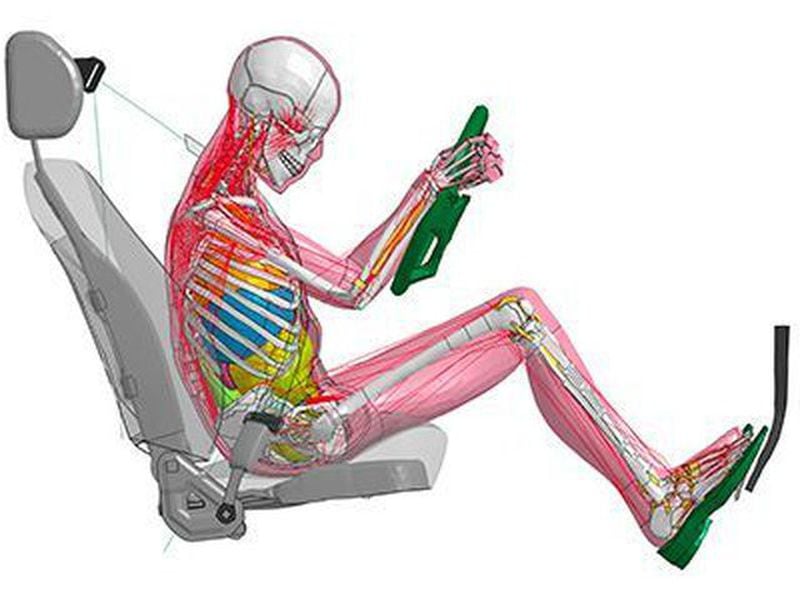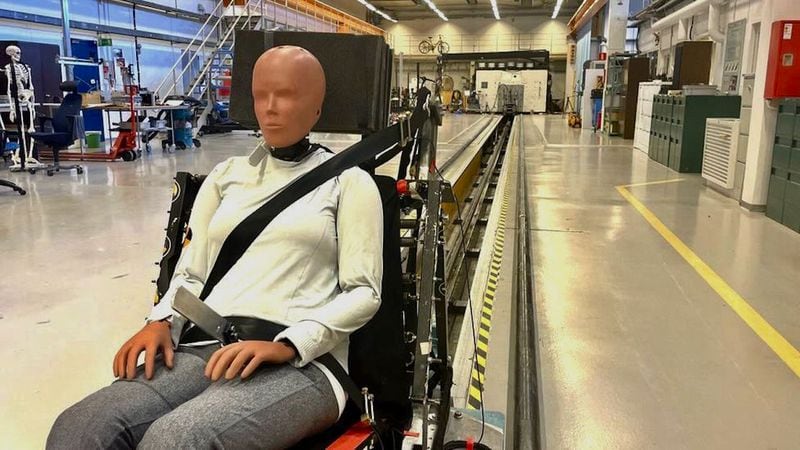Before its appearance, crash tests were carried out with corpses and animals. Unethical practices that ended with the creation of Sierra Samy, the first model in history. Since then, the evolution of these anthropomorphic dummies has not stopped, becoming today essential figures for improving automobile safety and occupant protection.
Did you know that -according to WHO data- every 24 seconds, a person dies in a road accident, reaching the unfortunate figure of 1.35 million deaths per year. Number which, without a doubt, would be much higher if there were no models. Yes, the dummies, those crash test dummies that have been with us for over 70 years.
The first mannequin in history was made in 1949 and was intended to test the reliability of ejection seats on US military aircraft. It was called sierra sam like its inventor, Samuel Anderson, who developed it for Sierra Engineering. It was a “95% percentile” doll. meaning he was taller and heavier than 95% of airplane pilots at the time, seeking not to fall short of his calculations.

Before Sam and his offspring, they experimented on corpses and animals. The first “crash tests”, yes, were not vehicles hitting walls, but with steel balls falling on dead bodies, which also caused them to fall into elevator shafts. Besides the ethical doubts associated with the use of cadavers, the fact that these came from people over the age of 70 meant that the results were not entirely valid, since the victims of traffic accidents were of all ages. .
For its part, animal testing was primarily on pigs due to their similar structure to human beings and because they could sit in a seat while driving a vehicle.
Family
When they realized that soldiers had more accidents driving cars than flying, that’s when they started thinking about dummies to test vehicle safety. Since then, their evolution has been unstoppable, making them more and more reliable in terms of weight, size and features (including knees, shoulders and spine).

From the base of modern mannequins, others were born with the aim of measuring the body’s response to very specific situations. For example, the SID family analyzes the effects on the spine, ribs and internal organs after a side impact. Meanwhile, the BioRID model predicts the effects of a rear impact and offers highly relevant data for developing head and neck restraint systems that mitigate the consequences of whiplash.
Likewise, the CRABI model reproduces the geometry of a small child to verify the effectiveness of child restraint systems. There are three copies, representing infants of 18, 12 and 6 months.

Currently, the most advanced manikin is the THOR 50M, whose high biofidelity is able to accurately measure variables such as chest compression, acceleration of the sternum, changes that occur in the skull or the consequences of a impact on the face, knees, heels and feet.
virtual mannequins
Generally, dummies last about three years, being subjected to two or three monthly tests. Its cost varies according to the required specifications, from eight thousand euros (about $7,000,000) up to 400,000 euros ($364 million). A high cost for a crash test laboratory, where an average of 200 different types of tests are recorded per year.
Thus, computer simulation is becoming more and more common, since the fact of not needing mannequins or real cars solves two important problems: economic and environmental.

The first virtual human modeling software is Toyota’s Total Human Model for Safety (THUMS). It was presented in 2000, at a meeting of the Society of Automotive Engineers in Japan, after three years of research.
This innovative program makes it possible to reproduce in a virtual way the consequences of all types of traffic accidents on the vehicle and the human body, representing with absolute fidelity the bone structures, the brain, the internal organs and the musculature.
Not only does it recreate the human body with great precision, but also, according to the Japanese firm, it simulates its vulnerability, based on the density and characteristics of each of its parts. In addition to the occupants of the vehicle, this simulator takes into account the damage that could be suffered by other people who could be involved, such as pedestrians for example.
To date, THUMS has received six updates. The first version depicted the bones of the human body in detail.

Later, in 2005, the detailed modeling of the face was added, arriving three years later the third edition, which included the reproduction of the brain. Internal organs entered the 2010 version, which offered variants for various physical typologies depending on the size, age, and gender of the occupant. Over time, anatomical features of children were also added. Already in 2015, Toyota integrated into its virtual mannequins all the musculature of the human body, perfected last year.
As this technology is computer software, it widens the field of action and makes it possible to carry out tens, hundreds or thousands of different analyzes by changing the conditions, which is not possible when tests are carried out with real vehicles and models.
in 2021 Toyota released the software called THUMS so that other manufacturers can access it for free and as part of their long-term vision for safer mobility.

The first of its kind
According to the National Highway Traffic Safety Administration (NHTSA) in the USA, Women are 73% more likely than men to be seriously injured in a car accident.
Despite this disturbing fact, until now there have been no female crash test dummy. Instead of creating a model with the average shapes and proportions of a woman, what was used was a scaled down version of a male mannequin.
It was only in 2011 that the first crash test focusing on the female physiognomy was carried out, but their skin tone only represented 5% of women, being 1.50 m tall and weighing 49 kg, the approximate dimensions of a 12 year old girl.

It was last year that a team of Swedish engineers finally developed the first female crash test dummy, with a height of 1.62 meters and a weight of 62 kilos measurements much more representative of the corporeality of an average woman.
Not only does the new test dummy’s chest and hips better represent female forms, but also her biomechanics, which generally have less muscle mass and strength than the average male body, but much greater flexibility.

In this regard, Astrid Linder, engineer and director of traffic safety at the Swedish National Institute for Transport and Road Research, who led the research team for the new dummy, said: “They are shorter and lighter and have different muscle strengths. “Because of this, they physically react differently in a car accident.”
Whether in real or virtual format, these neutral and unflappable looking mannequins, with the classic checkered calibration circles, They have been working for decades and ensuring our safety on board, so long live the whole model family.
Source: Latercera
I am David Jack and I have been working in the news industry for over 10 years. As an experienced journalist, I specialize in covering sports news with a focus on golf. My articles have been published by some of the most respected publications in the world including The New York Times and Sports Illustrated.


